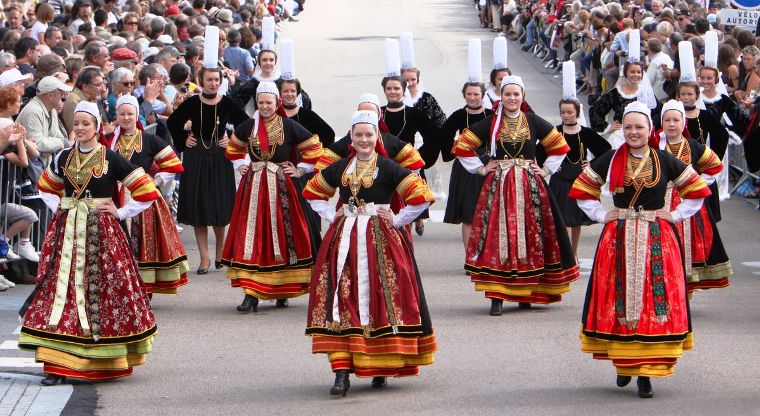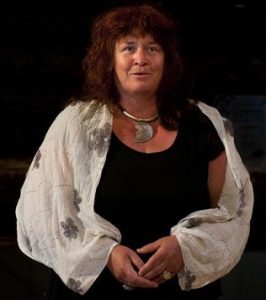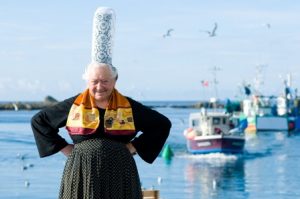
The past is present in western France, and that bodes well for the future.
Singer, songwriter and teacher, Louis-Jacques Suignard, is in a hurry. The 52-year-old Breton and his band Youhadenn are booked on the overnight sailing from Roscoff on France’s north coast to Ireland. He’s packing his bags with all he needs for four days of performing in Cork: a toothbrush, underwear, gifts from Brittany and, if he can find them, he laughs, some matching socks. He’s also taking his Irish bodhrán.
Youhadenn’s immersion in Celtic culture means that Irish ballads sit as easily in their repertoire as the traditional Breton songs — including gwerzioù and sonioù, laments and ballads — for which they are renowned.
 In jeans and open-necked shirts, with his sleeves rolled up, Louis-Jacques stamps the floor and wipes sweat from his brow as he sings – traditional kan ha diskan, tales of love, adventure and the sea.
In jeans and open-necked shirts, with his sleeves rolled up, Louis-Jacques stamps the floor and wipes sweat from his brow as he sings – traditional kan ha diskan, tales of love, adventure and the sea.
All his grandparents were native Breton speakers, but his parents belonged to a generation who were discouraged from speaking it.
“In the forties and fifties, schoolchildren in Brittany were brainwashed into thinking that their parents’ language was a tragic, shameful flaw that would jeopardize their lives and chances of social success. They had to reject it and learn French instead — ‘the language of a bright future’ — and be saved from archaism.”
The impact of that policy has been far-reaching. After the Second World War, the region hosted 1 million native speakers. Seventy years later, 200,000 remain in a population of 4 million. Most are over 60 and are concentrated in western Brittany.
Louis-Jacques’ mother, Annick, spoke Breton with her parents but refused to speak it to her son. She tried to dissuade him from studying it at UBO, the University of Western Brittany. Finally, after attending one of his concerts, her attitude changed.
“I was singing my own songs in our common Breton language,” Louis-Jacques explains.
“She realized the audience was understanding and sharing. Breton was no longer a thing of the past for her. It was something to be proud of.
“She agreed to do for my children what she refused to do for me – speak Breton. We’re lucky.”
Garvan, the musician’s 17-year-old son, regularly joins him on stage to jointly celebrate their culture. Circumstances differ, but the outcome is the same: traditional Breton music is the catalyst for a new appreciation of a rich cultural heritage.
A glance at the website for Tamm-Kreiz — set up 13 years ago to promote traditional music events — lists a thousand festoù-noz, or night festivals, taking place throughout the year.
Linking arms and grouping themselves into circles, hundreds of dancers of all ages shuffle about gently in readiness for an age-old routine. Two unaccompanied singers break into kan ha diskan, ‘singing and re-singing’; alternately, a pair playing a binioù and bombard provide an instrumental version of the same ‘call and response’ performance.
Casually dressed in baggy shirts, jumpers and jeans, long floating skirts, or short skirts and boots, the motley troupes tap, side-step and gently hop in hypnotic, revolving circles to rhythms passed down through generations.
Whether the dancers are moving to an a cappella ballad or gavotte, or to the acoustic shrill of the Breton bagpipe and bombard, the melodies set feet tapping. Unfamiliar music begins to feel familiar, connecting with something deep-rooted, elemental and Celtic.
 Today the thriving Breton music tradition is among the healthiest in Europe. Every August, a love of traditional music and ‘Celtic rock’ brings enthusiasts from across the world to the spectacular Festival Interceltique de Lorient. In November, at the Yaouank festival in Rennes, 6,000 young people dance at huge fest-noz events to rock, jazz and techno arrangements of old and modern sounds.
Today the thriving Breton music tradition is among the healthiest in Europe. Every August, a love of traditional music and ‘Celtic rock’ brings enthusiasts from across the world to the spectacular Festival Interceltique de Lorient. In November, at the Yaouank festival in Rennes, 6,000 young people dance at huge fest-noz events to rock, jazz and techno arrangements of old and modern sounds.
More than 10,000 people play biniou, bombard and drums in bagadoù, looking and sounding similar to Scottish pipe bands; another 13,000 belong to ‘Celtic circles’ and celebrate Breton dance.
In 2012, UNESCO conferred international recognition on the Fest-Noz by listing it in the Intangible Cultural Heritage of Humanity. Citing the festivals as “communal gatherings passed from generation to generation” the UN agency highlighted their readiness to reinvent “according to changing times.”
Things have changed little in 150 years around the sunny stone cottage in Perros-Guirec, the home of 63-year-old Breton activist Gireg Konan. Evergreen jasmine nightshade, laden with clusters of blue and white blossoms, climbs across its granite facade and around the blue wooden shutters and window frames.
The retired teacher recounts with pride how the house belonged to a sailor whose wife raised their children and tended to a cow, pig, chicken and rabbits while he stayed at sea. It was built in 1865 “in the traditional way” – on a framework of oak sawn from trees around their small farm, and stones from the quarry one hundred yards away.
“Being a proud Breton means being ready to live your life, culture and language in Brittany. Being a proud Breton is being proud of what you are, where you come from, and being ready to assume what goes with it.”
Gireg comes from a long line of native speakers and shares a name with the Welsh monk who founded Perros-Guirec 1500 years ago. When he was born, his parents were forbidden under an 1803 French law from giving him a Breton name.
With characteristically Breton determination, his father argued that ‘Gireg’ was the patron saint of Perros-Guirec, and the authorities eventually relented. The original law has been relaxed but Gireg is still obliged to use his name in French, Guirec Connan, for official purposes.
The government’s ongoing refusal to officially recognize minority languages militates against Breton’s survival as a spoken tongue. It is the only living Celtic language without official status, and is classified by UNESCO as “endangered”.

While growing numbers of children and adults are learning it, Gireg worries that the will to speak Breton may become merely aspirational.
“It isn’t correct to describe the state of our language as ‘healthy’,” he reflects. “Rather, its social base is changing from typically rural to urban, and it’s becoming, like Irish, a ‘hoped for’ or ‘wished for’ language where everyone can or could speak it, but doesn’t.”
One hundred thousand people understand Breton but do not use it. Supporters, like Gireg, believe its future depends on it being taught at school.
“No more progress is possible under the current system. Our schools need more money and attention but we’re blocked by the State. We’ve little more than one hour’s television per week.”
He lists a host of organizations, including the Ofis Publik ar Brezhoneg — the Breton Language Office — and the regional assembly that are promoting Breton’s use in everyday life; the proliferation of bilingual road signs suggests progress.
He predicts, however, a growing Breton clamour for political independence or greater autonomy, at least, “if France doesn’t become a federal state, respecting every citizen.
“The assembly uses 1% of our taxes and helps as much as it can but it’s never enough. We need another level of decision-making.
“The question now is how to go from a passive form of language and culture to an active one.”
Paradoxically, while the number of Breton speakers is dwindling through age, the number of children learning bilingually is up a third in 10 years. 16,000 are now studying Breton at the self-funded, ‘immersion’ method Diwan schools or in private Catholic and public schools.
On an unseasonably wet Thursday, 6,000 people donned waterproof jackets or plastic capes for the Tro Menez Are, the annual fund-raiser for the Diwan school in Kommanna. For one day only, landowners open their gates and make previously inaccessible countryside available to ramblers for an 8 euro fee. Appropriately, this year’s theme was ‘water’.
Undeterred by the downpours, supporters of all ages — some wheeling pushchairs, others leading dogs — assembled in Sizun from 7.30 a.m. onwards. They registered for one of seven walks, ranging from five to forty kilometers.
Armed with maps, refreshments and hiking sticks, they set off to climb the hills of Monts d’Arrée, explore woodlands and country lanes, follow fast-flowing rivers and gaze in wonder at ancient bridges, fountains and calvaires — medieval crucifixion sculptures found in churchyards across western Brittany.
Kommanna is a town of 1ooo residents, where half the children are educated bilingually. Among those busily entertaining youngsters and helping at stalls was grandmother, music teacher and renowned traditional singer, Brigitte Kloareg.
 The spirited, red-haired 60-year-old enthusiastically promotes Brittany’s oral heritage. She remains angry at being denied a chance to learn Breton as a child. Though her great-grandmother was monolingual, and her paternal grandparents spoke Breton to each other, they didn’t pass it on to her father.
The spirited, red-haired 60-year-old enthusiastically promotes Brittany’s oral heritage. She remains angry at being denied a chance to learn Breton as a child. Though her great-grandmother was monolingual, and her paternal grandparents spoke Breton to each other, they didn’t pass it on to her father.
As a teenager, Brigitte tried unsuccessfully to learn it from recordings. Remarkably, a few years later, she mastered Breton’s sister language, Welsh, during just four weeks in Wales; she later learned Breton through that medium. Even now, she can’t speak Breton as fluently as Welsh, although she is equally at ease singing in either.
“Song is a safer place for me. When I was growing up, I couldn’t find the key to Breton. I’d be in tears, in pain, feeling barbaric. The present didn’t make any sense.
“Wales opened a door and put the pieces of the puzzle in place for me. Wales made sense of what I was and gave my life a meaning.”
Fifteen years ago, the accomplished linguist moved back to Brittany after two decades in Wales. Cultural diversity, whether in Breton, Welsh or the Gallo of eastern Brittany, is precious to her. Acknowledging that Diwan schools struggle to fund themselves, she is horrified to think that Breton could disappear.
“It’s hard to be optimistic when you’re fighting against a major, well-established culture that offers no state support. But it gives me a good feeling that my grandchildren and 16,000 others are learning Breton. I hoped, though, that double that number would be learning.
“To understand a country, you need to decipher its past. If you don’t make sense of your past, you cannot understand your present. You cannot have a future.”
At his home in Saint Yvi, Dr. Gary German from the UBO is finalizing details of a summer school to unlock some of the region’s past. Uniquely, it offers language students an opportunity to learn within a Breton cultural setting.

The Centre for Breton and Celtic Research wants to introduce Brittany’s Celtic linguistic and cultural heritage to a wider audience. Dr. German points out that although the Breton-speaking population is shrinking, Brittany has more native speakers than Scotland and Ireland combined.
“Despite this, Breton is ‘the poor man’ of Celtic Studies. Brittany is virtually unknown in scholarly circles.”
He is greatly encouraged by the number of students from America and England, and other Celtic regions, that have enrolled for the summer school. Its emphasis is on the spoken word, with local native speakers participating to give valuable experience of the “living language.”
The academic, who was born in Brittany to an American father, and a mother who prefers not to speak Breton, recounts coming across three elderly men as they chatted in the ancient language.
“When they saw me approaching, they switched to French. Old people are ashamed to be discovered knowing or speaking Breton. It’s no longer a community language. The language of farmers and fishermen is now hidden.”
He recalls fondly how his great-grandfather, who learned French in the First World War, translated obituaries into Breton for his monolingual wife. “She wore a traditional white lace headdresses — the coiffe of Fouesnant — and the most beautiful one in Brittany, in my opinion.”
His maternal grandmother eventually taught him Breton. “‘Learn another language like Spanish or Italian to help you get ahead in the world,’ she’d say.
“As time went on, and I persisted, she came to enjoy our new bond as she unveiled the secrets of the Cornouaillais dialect and the culture that only a knowledge of Breton can reveal.”
That persistence is characteristic of many language proponents, and in keeping with the Bretons’ historical reputation for being tough and resilient.
The spirit that motivated the first Diwan parents to establish separate schools mirrors the thinking behind Produit en Bretagne, established in 1993 to boost the economy and create employment while simultaneously promoting Breton culture. Changes in farming and fishing, Brittany’s biggest industries, claimed many jobs and decimated the small rural communities which sustained the Breton language.
 “If we want our economy to develop,” explains manager, Malo Bouëssel du Bourg, “we have to do it ourselves. It has to be a collective approach, bringing together culture and the economy, mobilizing everybody in Brittany.”
“If we want our economy to develop,” explains manager, Malo Bouëssel du Bourg, “we have to do it ourselves. It has to be a collective approach, bringing together culture and the economy, mobilizing everybody in Brittany.”
Produit en Bretagne’s outward-looking strategy fits naturally with the approach of the region as a whole. Although peripheral in mainland Europe, it is well positioned to benefit from technological advances. Car manufacturing is now its third biggest industry. Its ICT sector employs 42,000 people, almost a third in research and development.
Browsing through shops or visiting town centers, in family stores and supermarkets, the impact of Produit en Bretagne is clear. More than 350 businesses, services and institutions are affiliated to it, employing 100,000 people.
Buildings and transport display its distinctive logo — a white lighthouse against a blue map of Brittany — as do 4,000 products, many labeled bilingually. More than 60 stores in Brittany and ten in Paris boast a ‘Brittany corner’, boldly declaring its origins in the black and white stripes of the Breton flag.
Malo takes pride in this modern, “open to the world”, business-like image. As a writer, he relishes Breton’s heightened profile in music and literature; one hundred books are now being published in Breton every year.
“Twenty years ago, there were only two Breton theatrical companies,” he notes. “Today there ten times that amount — producing and presenting in our language, bringing it into popular culture.
“Like biodiversity, cultural diversity is best for the world. We must build relations with other cultures and be open to the world if our culture is to stay alive.”
The father-of-five worked in the wine trade on France’s Mediterranean coast before joining Produit en Bretagne. He grew up in eastern Brittany, well away from the Breton heartland, and only became fluent at 40.
“I love Breton. I create in this language. It’s part of a rich culture from far and deep in the past. I love French too, but Breton feels different and I want to participate.”
Language has long been regarded as a key pillar of regional identity. Early in the twentieth century, the Irish revolutionary and poet, Pádraig Pearse, wrote, “Tír gan teanga, tír gan anam” — a country without a language is a country without a soul.

Celtic Brittany certainly has a soul. Language, music, education, trade and art all contribute to it. Despite obstacles in its path, it transcends nationality and crosses borders and oceans to reach out to Celts everywhere.
While most Bretons remain indifferent to activists’ objectives, successive polls show that 90 per cent are proud of their ancestry and regional distinctiveness.
Brigitte Kloareg is one such person and sees it as her duty to promote Breton language and culture. Still, she dismisses the notion of nationhood.
“When I stand in Wales or Ireland or the middle of Orkney, I see my world all around me. My country is the Celtic world.”




















A Chara uasail –
It is my wish, with a group of volunteers, to set up a purely cultural FB page, which sets out the heritage of the Celts (ourselves, the Irish, indeed) from ancient times to today. To provide this would be to break new ground. Both the paths of Celtic migration west, from the Urheimat (the Original Homeland of the Indo-Europeans) and to the East, will be covered. Being Celts, we went in every direction! One aim we have is to point to the close ties between the Irish and Breton cultures.
In the URL below, is a picture of people in traditional Breton dress, over the title ‘The past is present in western France, and that bodes well for the future.’ The picture would provide a fine backdrop to our saying that Breton – Brezhoneg – is a linguistic cousin of Irish – an Ghaedhealg. I should so wish to ask you, please, for permission (with attribution to CelticLife-International) to use the picture, on the FB page.
Le buíochas mór –
Dr Liam Réamonn
https://celticlifeintl.com/french-celtic-connection/